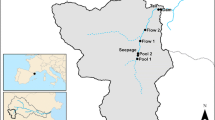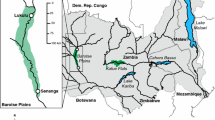Abstract
In Mediterranean regions, drought is one of the main factors shaping fluvial ecosystems. Droughts cause a shift from lotic to lentic conditions, triggering a gradual fragmentation of the longitudinal hydrological continuum, and a severe alteration of water chemical properties. However, within a biogeochemical perspective, little is known about how and to which extend droughts modify the chemical properties of dissolved organic matter (DOM). In this study, the variability of DOM properties along a fragmented fluvial system is explored, during a summer severe drought, by means of (a) the ratio between dissolved organic carbon and nitrogen concentrations (DOC:DON); (b) DOC bioavailability (BDOC) and (c) DOM optical properties (SUVA index, fluorescence index, and excitation–emission fluorescence matrices). DOM and water measurements were collected from isolated water parcels that became disconnected from the fluvial continuum at different times, and were compared with data obtained in the following autumn, when the fluvial continuum was re-established. Analysis of DOM chemical properties evidenced that these properties during drought clearly differed from those observed in autumn, but changes did not follow an arbitrary pattern. Thus, the sampling sites with lotic water bodies showed DOM properties similar to those observed in autumn reflecting the dominance of terrestrial inputs. But, once hydrological fragmentation occurred, there was a gradual increase in the contribution of autochthonous DOM as the time elapsed since the pools were established, and the geochemical conditions shifted from oxidized to reduced conditions. In consequence, the fragmentation of fluvial continuum generates a set of distinct biochemical hot spots (i.e., each water parcel), revealing that extreme drought greatly amplifies the qualitative heterogeneity of organic matter in a fluvial system.







Similar content being viewed by others
References
Acuña V, Munoz I, Giorgi A et al (2005) Drought and postdrought recovery cycles in an intermittent Mediterranean stream: structural and functional aspects. J N Am Benthol Soc 24(4):919–933
Amon RMW, Benner R (1996) Bacterial utilization of different size classes of dissolved organic matter. Limnol Oceanogr 41:41–51
Battin TJ, Kaplan LA, Findlay S et al (2008) Biophysical controls on organic carbon fluxes in fluvial networks. Nat Geosci 1(2):95–100
Bernal S, Butturini A, Sabater F (2005) Seasonal variations of dissolved nitrogen and DOC:DON ratios in an intermittent Mediterranean stream. Biogeochemistry 75:351–372
Bertoldi W, Zanoni L, Tubino M (2009) Planiform dynamics of braided streams. Earth Surf Process Landform 34(4):547–557
Bleich ME, Moraes Lima Silveira R, Barros Nogueira FM (2009) Limnological patterns in Northern pantanal lagoons. Brazil Arch Biol Technol 52(3):755–764
Bostrom B, Andersen JM, Fleischer S, Jansson M (1988) Exchange of phosphorus across the sediment–water interface. Hydrobiologia 170:229–244
Butturini A, Bernal S, Nin E (2003) Influences of the stream groundwater hydrology on nitrate concentration in unsaturated riparian area bounded by an intermittent Mediterranean stream. Water Resour Res 39(4):1110–1123
Butturini A, Alvarez M, Bernal S, Vazquez E, Sabater F (2008) Diversity and temporal sequences of forms of DOC and NO3-discharge responses in an intermittent stream: predictable or random succession? J Geophys Res 113(G3):3016
Clark JM, Chapman PJ, Adamson JK, Lane SN (2005) Influence of drought-induced acidification on the mobility of dissolved organic carbon in peat soils. Global Change Biol 11:791–809
Coble PG (1996) Characterization of marine and terrestrial DOM in seawater using excitation–emission matrix spectroscopy. Mar Chem 51:325–346
Dahm CN, Baker MA, Moore DI, Thibault JR (2003) Coupled biogeochemical and hydrological responses of streams and rivers to drought. Freshw Biol 48:1219–1231
Fazi S, Amalfitano S, Piccini C et al (2008) Colonization of overlaying water by bacteria from dry river sediments. Environ Micorbiol 10(10):2760–2772
Fellman JB, D’Amore DV, Hood E, Boon RD (2008) Fluorescence characteristics and biodegradability of dissolved organic matter in forest and wetland soils from coastal temperate watersheds in southeast Alaska. Biogeochemistry 88:169–184
Freeman C, Fenner N, Ostle NJ et al (2004) Export of dissolved organic carbon from peatlands under elevated carbon dioxide levels. Nature 430:195–198
Gasith A, Resh VH (1999) Streams in Mediterranean climate regions: abiotic influences and biotic responses to predictable seasonal events. Annu Rev Ecol Syst 30:51–81
Hach Company (1992) Analysis handbook, 2nd edn. Hach Company, Loveland, Co
Hedin LO, Armesto JJ, Johnson AH (1995) Patterns of nutrient loss from unpolluted, old-growth temperate forests. Evaluation of biogeochemical theory. Ecology 76:493–509
Hood E, McKnight DM, Williams MW (2003) Sources and chemical character of dissolved organic carbon across an alpine/subalpine ecotone, Green Lakes Valley, Colorado Front Range, United States. Water Resour Res 39(7):1188
Hood E, Gooseff MN, Johnson SL (2006) Changes in the character of stream water dissolved organic carbon during flushing in three small watersheds, Oregon. J Geophys Res 111(G1):1007
Jaffé R, McKnight D, Maie N et al (2008) Spatial and temporal variations in DOM composition in ecosystems: the importance of long-term monitoring of optical properties. J Geophys Res 113(G4):4032
Kaiser E, Arscott DB, Tockner K, Sulzberger B (2004) Sources and distribution of organic carbon and nitrogen in the Tagliamento River, Italy. Aquat Sci 66:103–116
Keeney DR, Nelson DW (1982) Nitrogen inorganic forms. In: Page AL (ed) Methods of soil analysis, part 2. Chemical and microbiological properties. Agronomy monographs # 9. AA-SSSA Publisher, pp 643–698
Kirchner JW, Feng XH, Neal C (2004) The fine structure of water-quality dynamics: the (high-frequency) wave of the future. Hydrol Process 18:1353–1359
Lake PS (2003) Ecological effects of perturbation by drought in flowing waters. Freshw Biol 48:1161–1172
McClain ME et al (2004) Biogeochemical hot spots and hot moments at the interface of terrestrial and aquatic ecosystems. Ecosystems 6:301–312
McDowell WH, Zsolnay A, Aitkenheah-Peterson JA et al (2006) A comparison of methods to determine the biodegradable dissolved organic carbon from different terrestrial sources. Soil Biol Biochem 38(7):1933–1942
McKnight D, Boyer BW, Westerhof PK et al (2001) Spectrofluorometric characterization of dissolved organic matter for indication of precursor organic material and aromaticity. Limnol Oceanogr 46(1):38–48
Milori DMBP, Martín-Neto L, Bayer C et al (2002) Humification degree of soil humic acids determined by fluorescence spectroscopy. Soil Sci 167(11):739–749
Mladenov N, McKnight D et al (2007) Chemical characterization of DOM in channels of a seasonal wetland. Aquat Sci 69:456–471
Ninyerola M, Pons X, Roure JM (2000) A methodological approach of climatological modelling of air temperature and precipitation through GIS techniques. Int J Climatol 20:1823–1841
Parlanti E, Wörz K, Geoffroy L, Lamotte M (2000) Dissolved organic matter fluorescence spectroscopy as a tool to estimate biological activity in a coastal zone submitted to anthropogenic inputs. Org Geochem 31:1765–1781
Rodriguez-Zuñiga FU, Bastos Pereira DM, Lopes da Silva WT et al (2008) Changes in optical properties caused by UV-irradiation of aquatic humic substances from the Amazon River basin: seasonal variability evaluation. Environ Sci Technol 42:1948–1953
Romaní AM, Vázquez E, Butturini A (2006) Microbial availability and size fractionation of dissolved organic carbon after drought in an intermittent stream: biogeochemical link across the stream–riparian interface. Microb Ecol 52:501–512
Rubbo MJ, Cole JJ, Kiesecker JM (2006) Terrestrial subsidies of organic carbon support net ecosystem production in temporary forest ponds: evidence from an ecosystem experiment. Ecosystems 9:1170–1176
Sachse A, Henrion R, Gelbrecht J, Steinberg CEW (2005) Classification of dissolved organic carbon (DOC) in river systems: Influence of catchment characteristics and autochthonous processes. Org Geochem 36:923–935
Servais P, Anzil A, Ventresque C (1989) Simple method for determination of biodegradable dissolved organic carbon in water. Appl Environ Microbiol 55:2732–2734
Sobczak WV, Findlay S (2002) Variation in bioavailability of dissolved organic carbon among stream hyporheic flowpath. Ecology 83:3194–3209
Stanhope JW, Anderson IC, Reay WG (2009) Base flow nutrient discharges from lower Delmarva Peninsula watersheds of Virginia, USA. J Environ Qual 38:2070–2083
Stedmon CA, Markager S (2005a) Resolving the variability in dissolved organic matter fluorescence in a temperate estuary and its catchment using PARAFAC analysis. Limnol Oceanogr 50(2):686–697
Stedmon CA, Markager S (2005b) Tracing the production and degradation of autochthonous fractions of dissolved organic matter by fluorescence analysis. Limnol Oceanogr 50(5):1415–1426
Stedmon CA, Markager S, Bro R (2003) Tracing dissolved organic matter in aquatic environments using a new approach to fluorescence spectroscopy. Mar Chem 82:239–254
Stepanauskas R, Leonardson L (1999) Bioavailability of wetland-derived DON to freshwater and marine bacterioplankton. Limnol Oceanogr 44(6):1477–1485
Stubbins A, Hubbard V, Uher G et al (2008) Relating carbon monoxide photoproduction to dissolved organic matter functionality. Environ Sci Technol 42(9):3271–3276
Vannote RL (1980) The river continuum concept. Can J Fish Aquat Sci 37(1):130–137
Vazquez E, Romani AM, Sabater F, Butturini A (2007) Effects of the dry–wet hydrological shift on dissolved organic carbon dynamics and fate across stream–riparian interface in a Mediterranean catchment. Ecosystems 10(2):239–251
Vidon P, Wagner LE, Soyeux E (2008) Changes in the character of DOC in streams during storms in two Midwestern watersheds with contrasting land uses. Biogeochemistry 88:257–270
Weishaar JL, Aiken GR, Bergamaschi BA et al (2003) Evaluation of specific ultraviolet absorbance as an indicator of the chemical composition and reactivity of dissolved organic carbon. Environ Sci Technol 37:4072–4708
Wilson HF, Xenopoulos MA (2009) Effects of agricultural land use on the composition of fluvial dissolved organic matter. Nat Geosci 2:37–41
Worrall F, Burt TP, Adamson JK (2006) Trends in drought frequency: the fate of DOC export from British peatlands. Clim Change 76(3–4):339–359
Acknowledgments
We thank the reviewers for strongly improving the earlier version of the manuscript. This study was funded by project CGL2007-0144/HID from the Ministerio de Ciencia e Innovación. Stefano Fazi and Stefano Amalfitano participation was supported by project CSIC-CNR ref 2006IT0010. Andrea Butturini and Eusebi Vazques are members of the GRACCIE consortium.
Author information
Authors and Affiliations
Corresponding author
Rights and permissions
About this article
Cite this article
Vazquez, E., Amalfitano, S., Fazi, S. et al. Dissolved organic matter composition in a fragmented Mediterranean fluvial system under severe drought conditions. Biogeochemistry 102, 59–72 (2011). https://doi.org/10.1007/s10533-010-9421-x
Received:
Accepted:
Published:
Issue Date:
DOI: https://doi.org/10.1007/s10533-010-9421-x




